Neurotransmitters: Dopamine
Avery Hamilton and Jim Hutchins
Chapter under construction. This is the first draft. If you have questions, or want to help in the writing or editing process, please contact hutchins.jim@gmail.com.
Introduction

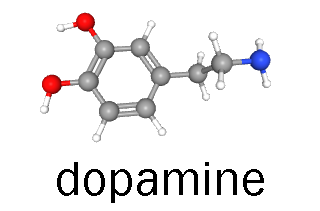 Dopamine, as the name suggests, is a catechol group (six-carbon ring with two red and white –OH groups) and an amino group (blue nitrogen plus 3 white H) connected by two methylenes (black and white –CH2–).
Dopamine, as the name suggests, is a catechol group (six-carbon ring with two red and white –OH groups) and an amino group (blue nitrogen plus 3 white H) connected by two methylenes (black and white –CH2–).
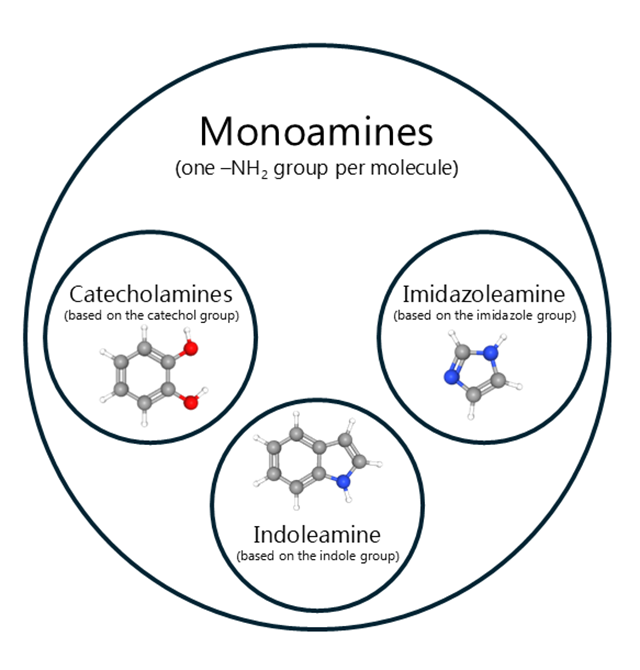 Dopamine is in the subcategory of monoamines (transmitters with one amino group) called catecholamines. The other catecholamine neurotransmitters, norepinephrine (noradrenaline) and epinephrine (adrenaline), are made from dopamine.
Dopamine is in the subcategory of monoamines (transmitters with one amino group) called catecholamines. The other catecholamine neurotransmitters, norepinephrine (noradrenaline) and epinephrine (adrenaline), are made from dopamine.
Dopamine has been called a “reward neurotransmitter”. While reward is one of the functions of dopamine, it is more properly thought of as a “reinforcement neurotransmitter”, reinforcing behavior regardless of whether it is triggered by reward or punishment. Dopamine causes a change in the anatomy and internal physiology of neurons and is an important component of the pathways that lead to synaptic growth and strengthening.
Synthesis of Dopamine
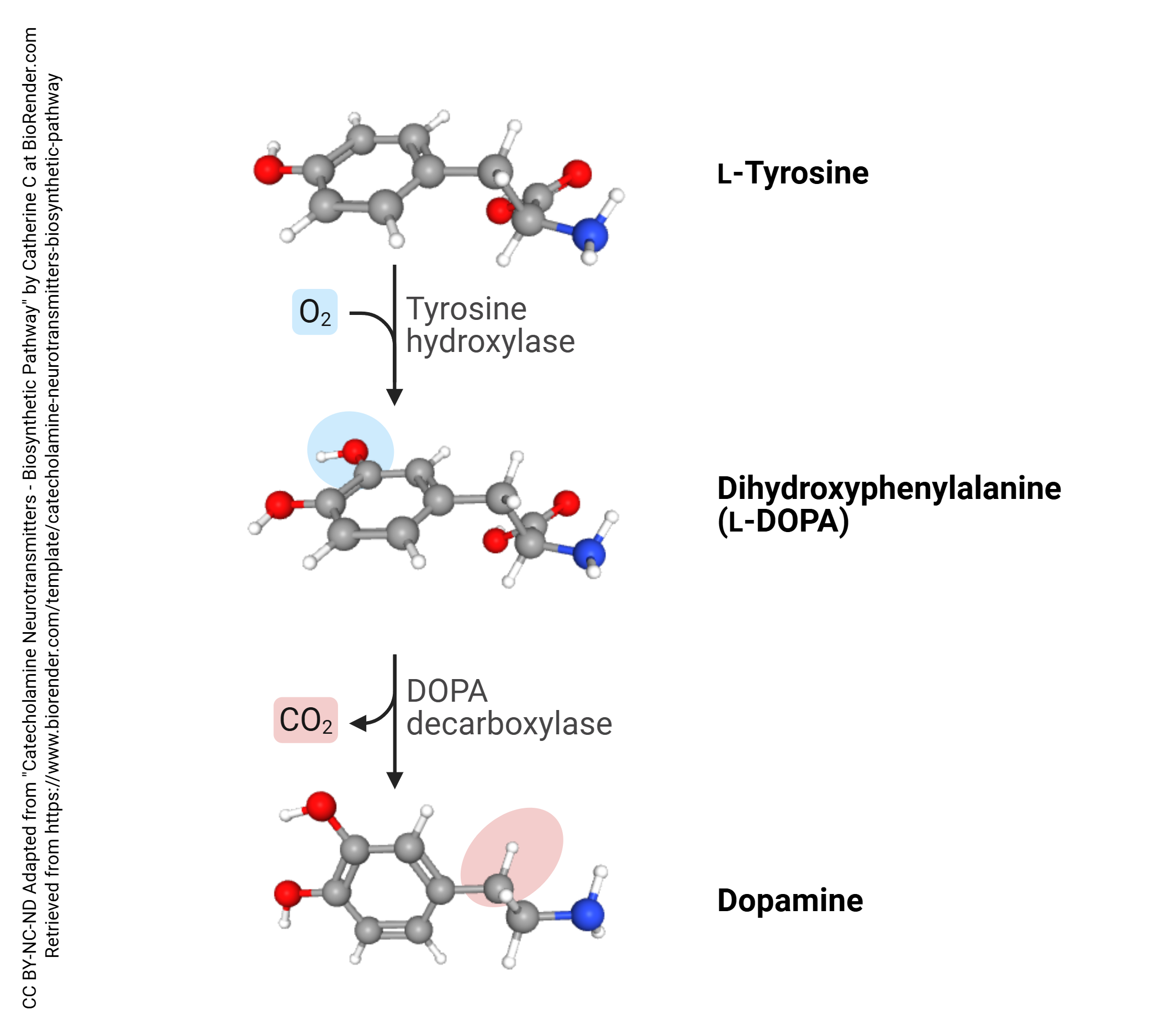 Dopamine is synthesized from the amino acid tyrosine. Tyrosine can be found in certain foods such as meat, eggs, legumes and dairy. Through phenylalanine hydroxylase (PAH), we catalyze the hydroxylation of phenylalanine (Phe) to make tyrosine (Tyr). From here tyrosine hydroxylase occurs and breaks tyrosine into L-DOPA(L-3,4-dihydroxyphenylalanine). Throughout the process of tyrosine hydroxylase a hydroxyl group is added to tyrosine. From here DOPA decarboxylase removed a carbonyl group (COOH) to produce dopamine. This process primarily takes place in dopaminergic neurons, which are located in various regions of the brain. Specifically, the substantia nigra, the ventral regimental area (VTA), and the hypothalamus.
Dopamine is synthesized from the amino acid tyrosine. Tyrosine can be found in certain foods such as meat, eggs, legumes and dairy. Through phenylalanine hydroxylase (PAH), we catalyze the hydroxylation of phenylalanine (Phe) to make tyrosine (Tyr). From here tyrosine hydroxylase occurs and breaks tyrosine into L-DOPA(L-3,4-dihydroxyphenylalanine). Throughout the process of tyrosine hydroxylase a hydroxyl group is added to tyrosine. From here DOPA decarboxylase removed a carbonyl group (COOH) to produce dopamine. This process primarily takes place in dopaminergic neurons, which are located in various regions of the brain. Specifically, the substantia nigra, the ventral regimental area (VTA), and the hypothalamus.
Packaging of Dopamine Into Vesicles
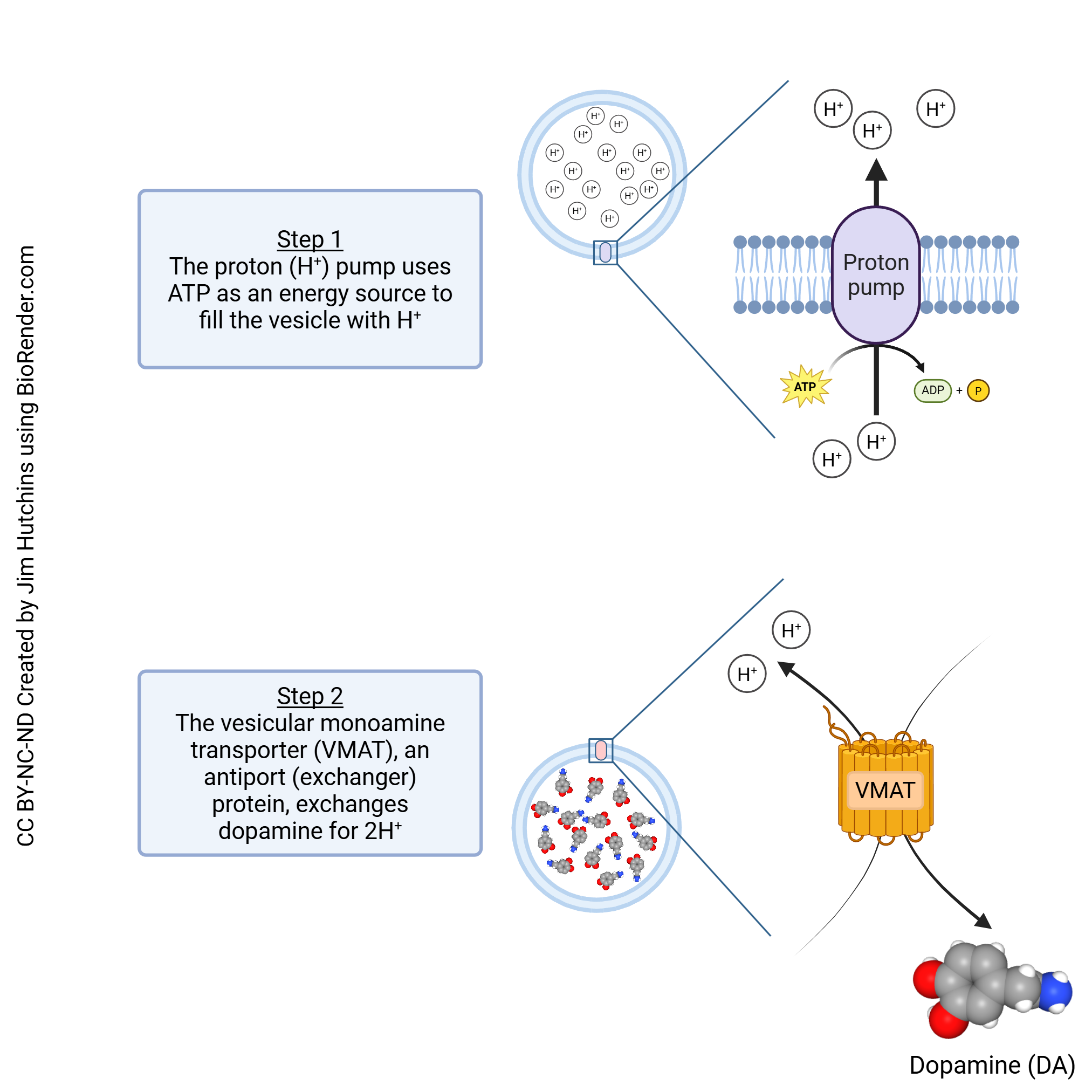 After dopamine is synthesized it is stored in vesicles within the nerve terminals of dopaminergic neurons. When dopamine is stored this way it helps prevent the neurotransmitter from prematurely breaking down. From here dopamine utilizes vesicular monoamine transporter (VMAT) to transport dopamine in vesicles within the presynaptic neuron. Dopamine is stored in this region until the neuron is activated. At the point of activation, an action potentials, the vesicles fuse with the cell membrane and release the dopamine into the synapse. When dopamine is released into the synapse it binds to dopamine receptors on the postsynaptic cleft.
After dopamine is synthesized it is stored in vesicles within the nerve terminals of dopaminergic neurons. When dopamine is stored this way it helps prevent the neurotransmitter from prematurely breaking down. From here dopamine utilizes vesicular monoamine transporter (VMAT) to transport dopamine in vesicles within the presynaptic neuron. Dopamine is stored in this region until the neuron is activated. At the point of activation, an action potentials, the vesicles fuse with the cell membrane and release the dopamine into the synapse. When dopamine is released into the synapse it binds to dopamine receptors on the postsynaptic cleft.
Storage and Metabolism
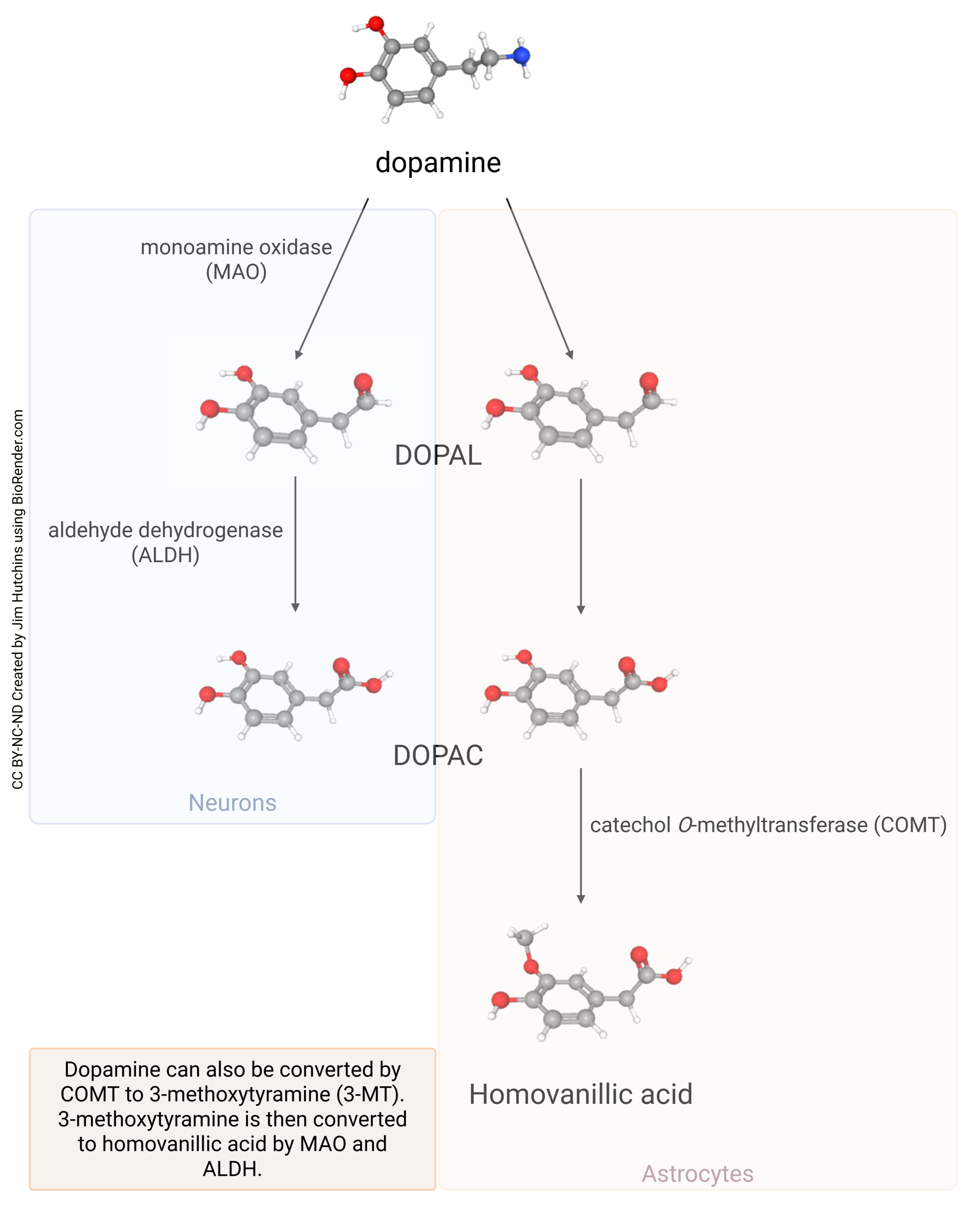 Dopamine must be cleared to allow the system to reset and it can be accomplished in two ways. The first way is through reuptake. This is when dopamine uses the dopamine transporter (DAT), on the presynaptic neuron to be repackaged into vesicles. The second way is to be metabolized by enzymes. The two primary enzymes for dopamine metabolism are monoamine oxidase (MAO) and catecholamine-O-methyltransferase (COMT). Monoamine oxidase can either be MAO-A or MAO-b but they both break dopamine down into dihydroxyphenylacetic acid (DOPAC). As for COMT, it takes DOPAC and further breaks it down into another metabolite called homovanillic acid (HVA), that is excreted through urine.
Dopamine must be cleared to allow the system to reset and it can be accomplished in two ways. The first way is through reuptake. This is when dopamine uses the dopamine transporter (DAT), on the presynaptic neuron to be repackaged into vesicles. The second way is to be metabolized by enzymes. The two primary enzymes for dopamine metabolism are monoamine oxidase (MAO) and catecholamine-O-methyltransferase (COMT). Monoamine oxidase can either be MAO-A or MAO-b but they both break dopamine down into dihydroxyphenylacetic acid (DOPAC). As for COMT, it takes DOPAC and further breaks it down into another metabolite called homovanillic acid (HVA), that is excreted through urine.
Dopamine Receptors
Dopamine is able to be effective because it binds to specific receptors in the postsynaptic neuron. These receptors belong to the G-protein-coupled receptor (GPCR) family. They can be divided into five main subtypes ranging from D1 through D5. Moreover, these receptors can be further divided into two groups. Where D1 and D5 are together and D2, D3, and D4 are in a group.
- D1 Receptors
- These are the most common types of dopamine receptors and they generally produce excitatory effects. They are involved in cognition and reward. They can be located in the striatum, cortex, and hippocampus.
- D2 Receptors
- As stated above, these receptors are inhibitory. They are involved in reward and dopamine release. Which connected them to movement and reward.
- D3 Receptors
- They are typically located in the limbic system, specifically the nucleus accumbens. D3 receptors are involved in impulse control and cognition.
- D4 Receptors
- They are found in areas like the hippocampus and prefrontal cortex. They are less understood than the other dopamine receptors, but there have been implications that they are linked to some psychiatric disorders.
- D5 Receptors
- Just as D1 receptors they are also excitatory. They are connected to cognition, decision making, and attention. These types of receptors can be found in both the hippocampus and hypothalamus.
Dopamine receptors ranging from D1-D5 are located in the four dopamine pathways of the brain. As stated in the previous chapter covering monoamines, there are several different significant pathways that DA follows (See Table 2). However, they all serve different purposes due to the wide variation in dopamine receptors (D1–D5) within each pathway.
Table 2. Dopamine Pathways
| Dopamine Pathway | Origin | Key Targets | Primary Function(s) |
|---|---|---|---|
| Mesolimbocortical | Ventral Tegmental Area (VTA) | Limbic System
Prefrontal Cortex (PFC) |
Reward Motivation
Cognition |
| Mesostriatal | Substantia Nigra | Striatum (Caudate Nucleus, Putamen) | Motor Control & Coordination |
- Nigrostriatal Pathway: Responsible for voluntary movement and balance. This pathway uses the basal ganglia, which includes the caudate, putamen, and globus pallidus (GP). All of which work together within a circuit involving the substantia nigra (SN) and the subthalamic nucleus. The nigrostriatal pathway contains around 80% of the brain’s dopamine. Furthermore, this pathway significantly affects individuals with Parkinson’s disease (Psychopharmacology Institute, n.d.).
- Mesolimbic Pathway: This pathway consists of two limbic brain structures with dopamine acting as a chemical messenger. Starting in the ventral regimental area (VTA), dopaminergic neurons form and extend to the nucleus accumbens (NA) of the forebrain. This pathway is referred to as the medial forebrain bundle and is what enables transmission of signals. The mesolimbic pathway is how behavior for reward is evaluated. This pathway is responsible for reinforcing effects, such as drugs to memory. Which ultimately leads to addiction (ScienceDirect, n.d.).
- Mesocortical Pathway: Similar to the mesolimbic pathway, dopaminergic neurons originate in the VTA. Through action potential signals are sent to the prefrontal cortex (PFC). As we know from previous chapters the prefrontal cortex is involved in both working memory and learning. So, if any dysfunction occurs in the pathway individuals would experience an inability to concentrate. Some studies even link low levels of dopamine in this pathway to schizophrenia because of its effects on cognition (Bepharco, 2022).
- Tuberoinfundibular Pathway: This pathway originates in the hypothalamus, specifically the periventricular and arcuate nuclei. The tuberoinfundibular pathways uses dopamine to regulate prolactin secreted from the pituitary gland (ScienceDirect, n.d.).
Roles of Dopamine
Dopamine is a multifaceted neurotransmitter. Providing both physiological and psychological functions for overall well-being. Dopamine is crucial for reinforcement, mood regulation, learning and memory and more. It can’t be simplified to just a “reward hormone” dopamine has extensive impact on the brain and body.
Dopamine in the Gut
Your gut microbiome is a key player in dopamine synthetization. Around 50% of dopamine in the body is actually synthesized in the gastrointestinal tract. Bacteria such as Eubacterium limosum and Blautia producta convert a compound in the gut into dopamine. That’s why gut health is important, it literally interferes with your mood through a bidirectional communication network. So, remember to eat your yogurt, it might just put you in a better mood (Hamamah et al., 2022).
Parkinson’s Disease
As stated above, dopamine plays an essential role in motor control. Individuals diagnosed with Parkinson’s have a significant loss of dopamine being produced in the substantia nigra. This leads to slowed movements, postural instability and more. Currently, there is no cure for Parkinson’s disease but there are medications that can help with symptoms. Treatment is targeted at increasing dopamine levels within the brain. This is achieved through dopamine agonists and MAO/ COMT inhibitors (American Association of Neurological Surgeons, 2024).
Phenylketonuria
Dopamine synthesis can be disrupted in unlikely ways. A good example of how neurological processes are all interconnected would be with individuals who have a diagnosis of phenylketonuria. This is a genetic condition where the body cannot properly metabolize the essential amino acid called phenylalanine. As discussed earlier, dopamine is synthesized from an amino acid called tyrosine which is derived from phenylalanine. When phenylalanine hydroxylase and tyrosine hydroxylase are disrupted it leads to a deficiency of dopamine production in the brain. This can lead to various neuropsychiatric symptoms like reduced motor control, irreparable cognitive impairment and behavioral problems (Curtius et al., 1981).
Dopamine is pivotal for maintaining our overall neurological health and treating disorders. It’s involved in complex processes that regulate motivation, mood, and cognition. Understanding how it’s synthesizes and released allows us to better understand various conditions like schizophrenia, Parkinson’s, and phenylketonuria.
References
American Association of Neurological Surgeons. (2024, May 9). Parkinson’s Disease – AANS. AANS. https://www.aans.org/patients/conditions-treatments/parkinsons-disease/#:~:text=Overview.%20Parkinson’s%20disease%20is%20a%20progressive%20disorder,to%20produce%20an%20important%20chemical%20called%20dopamine.
Bepharco. (2022, November 17). Four Major Dopaminergic Pathways & Association with Schizophrenia. Bepharco. https://bepharco.com/en-US/research-and-development-1/four-major-dopaminergic-pathways-association-with-schizophrenia#:~:text=Mesolimbic%20Dopamine%20Pathways,dopamine%20in%20the%20mesolimbic%20pathway.
Bhatia, A., Lenchner, J. R., & Saadabadi, A. (2023b, June 22). Biochemistry, dopamine receptors. StatPearls – NCBI Bookshelf. https://www.ncbi.nlm.nih.gov/books/NBK538242/#:~:text=D2:%20locomotion%2C%20attention%2C%20sleep,%2C%20cognition%2C%20attention%2C%20renin%20secretion
Curtius, H., Niederwieser, A., Viscontini, M., Leimbacher, W., Wegmann, H., Blehova, B., Rey, F., Schaub, J., & Schmidt, H. (1981). Serotonin and dopamine synthesis in phenylketonuria. Advances in Experimental Medicine and Biology, 277–291. https://doi.org/10.1007/978-1-4684-3860-4_16
Franco, R., Reyes-Resina, I., & Navarro, G. (2021). Dopamine in health and disease: much more than a neurotransmitter. Biomedicines, 9(2), 109. https://doi.org/10.3390/biomedicines9020109
Hamamah, S., Aghazarian, A., Nazaryan, A., Hajnal, A., & Covasa, M. (2022). Role of Microbiota-Gut-Brain axis in regulating dopaminergic signaling. Biomedicines, 10(2), 436. https://doi.org/10.3390/biomedicines10020436
Psychopharmacology Institute. (n.d.). https://psychopharmacologyinstitute.com/publication/the-four-dopamine-pathways-relevant-to-antipsychotics-pharmacology-2096
Watson, S. (2024, April 18). Dopamine: The pathway to pleasure. Harvard Health. https://www.health.harvard.edu/mind-and-mood/dopamine-the-pathway-to-pleasure#:~:text=Where%20is%20dopamine%20produced%3F,in%20a%20two%2Dstep%20process.
Zahoor, I., Shafi, A., & Haq, E. (n.d.). Figure 1, [Metabolic pathway of dopamine synthesis. . .]. – Parkinson’s Disease – NCBI Bookshelf. https://www.ncbi.nlm.nih.gov/books/NBK536726/figure/Ch7-f0001/#:~:text=Dopamine%20is%20synthesized%20from%20phenylalanine,a%20minor%20pathway%20by%20CYP2D6.
Media Attributions
- Dopamine Conformer © PubChem adapted by Jim Hutchins is licensed under a Public Domain license
- Dopamine Conformer © PubChem adapted by Jim Hutchins is licensed under a Public Domain license
- Monoamine venn diagram © PubChem adapted by Jim Hutchins is licensed under a CC BY-SA (Attribution ShareAlike) license
- Synthesis of dopamine © Catherine C adapted by Jim Hutchins is licensed under a CC BY-NC-ND (Attribution NonCommercial NoDerivatives) license
- Vesicular Monoamine Transporter © Jim Hutchins is licensed under a CC BY-NC-ND (Attribution NonCommercial NoDerivatives) license
- Metabolism of Dopamine © Jim Hutchins is licensed under a CC BY-NC-ND (Attribution NonCommercial NoDerivatives) license

